《国际经济学》院考考试范围
国际经济学重点考试内容

国际经济学重点考试内容1绝对成本;各国之间根据各自的优势进行分工,通过国际贸易使各国都能得利。
其错误主要表现在,认为交换引起分工,而交换又是人类本性所决定的。
事实上,交换以分工为前提,在历史上分工早于交换。
同时,交换也不是人类本性的产物,而是社会生产方式和分工发展的结果。
绝对成本说解决了具有不同优势的国家之间的分工和交换的合理性。
但是,这只是国际贸易中的一种特例。
如果一个国家在各方面都处于绝对的优势,而另一个国家在各方面则都处于劣势,那么,它们应该怎么办?亚当斯密的论述虽然精辟,但是存在很大的不足。
其中最主要的一点是它不能解释现实中所有国家之间国际贸易的基础,特别是当一个国家在所有部门的生产成本都处于绝对优势的话,上述分析就无法解释这一种情况.2在两国生产技术条件相同的条件下,国家之间要素禀赋的差异,最终会影响到两国两种商品的生产能力。
从而引起供给能力的差异。
一要素丰裕度较高,则在生产同种产品上的生产成本就相对较低,另外一国较高,这样的成本差别导致了产品价格的差异,成本低的国家产品价格就相对低,这样就在国际竞争中占据了优势,两国在生产不同的产品上都占据了比较优势,这样,一国出口密集使用其丰富要素的产品,进口其稀缺要素的产品,这样就产生了国际贸易。
3.进口配额是在保护数量,关税是贸易壁垒一种措施。
两者的出发点均是保护保护本国工业。
配额是一国在一年内进口国外某种产品的数量限制,关税则是对进口商品征收的税种,抬高其价格,增强了本国商品价格竞争力。
进口配额与关税都在保护本国产业方面能够发挥作用,不过,进口配额是比关税更加严厉的限制措施。
关税将导致进口产品价格一定幅度的上升(与关税幅度一致),当消费者对此种产品的需求上升以后,产品价格不会进一步上升;配额也会导致进口产品价格的上升,当消费者对此种产品的需求上升以后,由于配额已经确定,产品价格将会进一步上升。
所以,对消费者有利的是关税而非配额。
关税壁垒起保护作用的决定性因素还是在于消费者的需求。
国际经济学复习范围
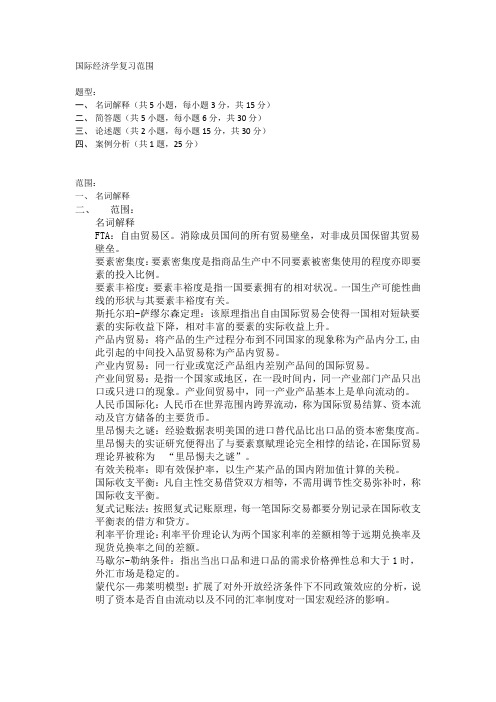
国际经济学复习范围题型:一、名词解释(共5小题,每小题3分,共15分)二、简答题(共5小题,每小题6分,共30分)三、论述题(共2小题,每小题15分,共30分)四、案例分析(共1题,25分)范围:一、名词解释二、范围:名词解释FTA:自由贸易区。
消除成员国间的所有贸易壁垒,对非成员国保留其贸易壁垒。
要素密集度:要素密集度是指商品生产中不同要素被密集使用的程度亦即要素的投入比例。
要素丰裕度:要素丰裕度是指一国要素拥有的相对状况。
一国生产可能性曲线的形状与其要素丰裕度有关。
斯托尔珀-萨缪尔森定理:该原理指出自由国际贸易会使得一国相对短缺要素的实际收益下降,相对丰富的要素的实际收益上升。
产品内贸易:将产品的生产过程分布到不同国家的现象称为产品内分工,由此引起的中间投入品贸易称为产品内贸易。
产业内贸易:同一行业或宽泛产品组内差别产品间的国际贸易。
产业间贸易:是指一个国家或地区,在一段时间内,同一产业部门产品只出口或只进口的现象。
产业间贸易中,同一产业产品基本上是单向流动的。
人民币国际化:人民币在世界范围内跨界流动,称为国际贸易结算、资本流动及官方储备的主要货币。
里昂惕夫之谜:经验数据表明美国的进口替代品比出口品的资本密集度高。
里昂惕夫的实证研究便得出了与要素禀赋理论完全相悖的结论,在国际贸易理论界被称为“里昂惕夫之谜”。
有效关税率:即有效保护率,以生产某产品的国内附加值计算的关税。
国际收支平衡:凡自主性交易借贷双方相等,不需用调节性交易弥补时,称国际收支平衡。
复式记账法:按照复式记账原理,每一笔国际交易都要分别记录在国际收支平衡表的借方和贷方。
利率平价理论:利率平价理论认为两个国家利率的差额相等于远期兑换率及现货兑换率之间的差额。
马歇尔-勒纳条件:指出当出口品和进口品的需求价格弹性总和大于1时,外汇市场是稳定的。
蒙代尔—弗莱明模型:扩展了对外开放经济条件下不同政策效应的分析,说明了资本是否自由流动以及不同的汇率制度对一国宏观经济的影响。
国际经济学考试大纲

《国际经济学》考试大纲教材名称《国际经济学》,科学出版社,邱继洲编,2005年版I、课程性质与设考目的和要求《国际经济学》课程是国际经济与贸易专业的专业主干课程。
《国际经济学》研究的是开放经济的资源配置以及由此发生的跨越国界的经济活动和经济关系。
其内容是阐述开放经济条件下的国际贸易理论、国际贸易政策、国际金融理论、国际金融政策等。
《国际经济学》的先行课程主要是《国际贸易》、《国际金融》、《国际经济合作》、《国际贸易实务》。
通过本课程学习,可以进一步提高分析问题和解决问题的能力。
通过本课程的学习,要求学生全面地、系统地掌握国际经济学的基本理论、国际经济学的基本方法、重视理论分析与经验分析的统一,并兼顾实证分析和规范分析。
Ⅱ、考核目标第一章比较优势理论一、考核知识点1、绝对优势原理;2、比较优势原理;3、机会成本与比较优势;4、成本递增条件下的国际贸易二、考核要求1、识记:绝对优势原理和比较优势原理、机会成本2、领会:绝对优势原理与比较优势原理的关系、机会成本与比较优势的关系、成本递增的贸易模式第二章贸易均衡理论一、考核知识点1、均衡分析:生产可能性曲线和社会无差异曲线;2、均衡分析:供给曲线和需求曲线3、提供曲线与贸易条件4、基于偏好差异的国际贸易二、考核要求l、识记:生产可能性曲线、社会无差异曲线、供给曲线、需求曲线、提供曲线、贸易条件、偏好差异2、领会:国际贸易的一般均衡分析、国际贸易的局部均衡分析、贸易条件的含义第三章要素禀赋理论一、考核知识点1、H—O模型2、国际贸易对短期生产要素收入的影响3、斯托尔珀一萨缪尔森定理4、要素价格均等化定理5、里昂惕夫之谜二、考核要求1、识记:要素密集度、要素丰裕度、斯托尔珀----萨缪尔森定理、要素价格均等化定理、里昂惕夫之谜、要素密集度变换2、领会:H—O模型的内容、国际贸易与要素收入分配的关系、要素价格均等化定理的含义、里昂惕夫之谜的解释、第四章现代贸易理论一、考核知识点1、规模经济与国际贸易2、不完全竞争与国际贸易3、需求结构贸易理论4、技术差距贸易理论二、考核要求l、识记:规模经济、垄断竞争、差别产品2、领会:规模经济与国际贸易的关系、行业内贸易的概念与产生原因、偏好相似理论的内容、技术差距贸易理论的内容。
经济学院考研复试笔试《国际经济学》课程大纲.doc

华中科技大学经济学院硕士研究生入学考试复试笔试《国际经济学》课程大纲(西方经济学、世界经济、国际贸易学专业考)考研《国际经济学》大纲第一部分考试说明一、考试的学科范围系统掌握国际经济学的一般原理及应用,包括国际贸易纯理论、贸易政策理论与实践、国际要素流动、外汇理论与政策、国际收支及国际收支调整的理论与政策、国际货币制度等。
考查要点详见本纲第二部分,考试样题参见本纲第三部分。
二、评价目标《国际经济学》在考查基本知识、基本方法和基本理论的基础上,注重考查考生运用《国际经济学》的基本理论和方法,分析和解决实际问题的能力.考生应能:。
准确掌握国际贸易和国际金融的有关概念;。
准确掌握国际贸易和国际金融的有关理论和分析方法;。
运用国际经济学的有关概念、理论和方法,分析现实的国际经济问题。
三、考试形式和考卷结构(一)答卷方式:闭卷,笔试。
(二)答题时间:分钟。
(三)各部分内容考查比例(满分为分):国际贸易部分国际金融部分(四)题型比例 .名词解释。
分析题 .问答题(五)参考书目:方齐云编:《国际经济学》,华中科技大学出版社。
方齐云,方臻旻编著,东北财经大学出版社.第二部分考查要点绪论.国际经济学。
国际经济学的内容和研究方法.国际经济学与一般经济学的关系。
.贸易依存度,出口依存度与进口依存度。
第一章国际贸易理论的微观基础.国际贸易理论的研究对象与目的。
.国际贸易理论的基本分析方法与模型框架.生产可能性曲线.机会成本。
封闭经济均衡。
开放经济均衡.贸易利益..国际贸易的起因..贸易提供曲线。
第二章古典贸易理论.古典贸易理论的演变。
.绝对利益论与比较利益论。
.比较利益论的生产可能性曲线与无差异曲线分析.第三章要素禀赋理论.要素丰富与要素密集。
要素禀赋理论的基本假设及结论。
.-定理。
要素价格均等化定理。
罗伯津斯基定理。
悲惨增长(贫困化增长)..里昂惕夫之谜及其解释。
第四章特定要素与国际贸易.特定要素模型。
.国际贸易与收入分配。
国际经济学考试大纲
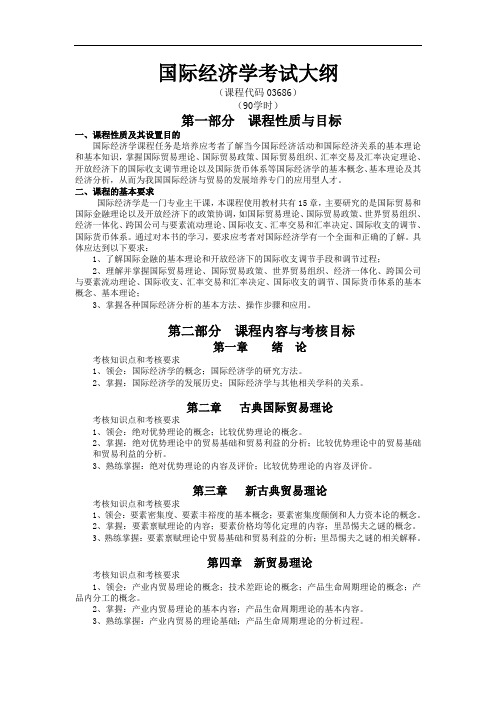
国际经济学考试大纲(课程代码03686)(90学时)第一部分课程性质与目标一、课程性质及其设置目的国际经济学课程任务是培养应考者了解当今国际经济活动和国际经济关系的基本理论和基本知识,掌握国际贸易理论、国际贸易政策、国际贸易组织、汇率交易及汇率决定理论、开放经济下的国际收支调节理论以及国际货币体系等国际经济学的基本概念、基本理论及其经济分析,从而为我国国际经济与贸易的发展培养专门的应用型人才。
二、课程的基本要求国际经济学是一门专业主干课,本课程使用教材共有15章,主要研究的是国际贸易和国际金融理论以及开放经济下的政策协调,如国际贸易理论、国际贸易政策、世界贸易组织、经济一体化、跨国公司与要素流动理论、国际收支、汇率交易和汇率决定、国际收支的调节、国际货币体系。
通过对本书的学习,要求应考者对国际经济学有一个全面和正确的了解。
具体应达到以下要求:1、了解国际金融的基本理论和开放经济下的国际收支调节手段和调节过程;2、理解并掌握国际贸易理论、国际贸易政策、世界贸易组织、经济一体化、跨国公司与要素流动理论、国际收支、汇率交易和汇率决定、国际收支的调节、国际货币体系的基本概念、基本理论;3、掌握各种国际经济分析的基本方法、操作步骤和应用。
第二部分课程内容与考核目标第一章绪论考核知识点和考核要求1、领会:国际经济学的概念;国际经济学的研究方法。
2、掌握:国际经济学的发展历史;国际经济学与其他相关学科的关系。
第二章古典国际贸易理论考核知识点和考核要求1、领会:绝对优势理论的概念;比较优势理论的概念。
2、掌握:绝对优势理论中的贸易基础和贸易利益的分析;比较优势理论中的贸易基础和贸易利益的分析。
3、熟练掌握:绝对优势理论的内容及评价;比较优势理论的内容及评价。
第三章新古典贸易理论考核知识点和考核要求1、领会:要素密集度、要素丰裕度的基本概念;要素密集度颠倒和人力资本论的概念。
2、掌握:要素禀赋理论的内容;要素价格均等化定理的内容;里昂惕夫之谜的概念。
《国际经济学》硕士研究生招生考试大纲

《国际经济学》硕士研究生考试大纲(同等学力考生加试科目)一、考试性质《国际经济学》考试是财经类专业硕士研究生入学考试科目之一,是教诲部授权各招生院校自行命题的选拔性考试。
其目的是测试考生对国际贸易、国际金融等基础知识和分析、解决问题主意的控制程度。
该考试大纲遵照教诲部经济学课程指导小组的基本要求,结合我校经济学专业对考生的知识要求制订。
大纲力求反映专业特点,以科学、平等、确切、规范的尺度去测评考生的经济学相关知识水平、基本判断素质和综合应用能力。
二、评价目标(1)对国际经济学相关基础知识的控制是否全面。
(2)对国际经济学基本主意的理解深度和综合应用能力。
三、考试内容及范围(一)国际贸易部分1、基本要求控制古典国际贸易理论、新古典国际贸易理论、现代国际贸易理论的基本观点及其意义。
了解国际贸易政策,并能按照基本理论和政策分析相关的经济现象。
2、考试范围:重商主义的贸易理论;李嘉图原理;俄林—赫克歇尔模型;制成品贸易;产品内贸易;经济地理与国际贸易;贸易保护理论;战略贸易理论;贸易壁垒;跨国公司与直接投资;跨国公司与技术转移(二)国际金融部分1、基本要求了解国民收入核算和国际收支平衡;控制汇率以及外汇市场的基本含义、种类、外汇市场资产需求及外汇市场均衡;控制国际货币制度的内容及其演变;了解最优货币区及其欧洲的经验2、考试范围:展开经济下的核算框架;休谟的“价格-铸币”流动机制理论;展开经济中的乘数分析;弹性主意;吸收主意;常常项目的普通均衡模型;资本流动;汇率政策四、考试形式和试卷结构(一)考试时光考试时光为180分钟。
(二)答题方式答题方式为闭卷、笔试。
试卷由试题和答题纸组成。
答案必须写在答题纸相应的位置上。
(三)试卷满分及考查内容分数分配试卷满分为150分。
(四)试卷可能包括的题型1、挑选题:每个问题都有若干个挑选,按照题目内容挑选其一个准确答案。
2.判断题:按照题目内容判断其描述问题的准确性。
3.简答题:按照题目要求,简要回答问题。
国际经济学考试重点汇总

1.什么是国际经济学?以经济学的一般理论为基础,研究国际经济活动和国际经济关系,是一般经济学理论在国际经济活动范围中的应用与延伸,是经济学体系的有机构成部分,属于应用经济学。
2.国际经济学发展脉络。
3.相关概念:✧国际贸易,是指不同国家(和/或地区)之间的商品和劳务的交换活动。
✧对外贸易,是指一个国家(地区)与另一个国家(地区)之间的商品、劳务和技术的交换活动。
✧对外贸易依存度,是指一国的进出口总额占该国国民生产总值或国内生产总值的比重,反映一国对国际市场的依赖程度,是衡量一国对外开放程度的重要指标。
进口总额占GDP的比重称为进口依存度,出口总额占GDP的比重称为出口依存度。
✧对外贸易条件,是指一个国家在一定时期内出口商品价格与进口商品价格之间的对比关系,反映了该国当年的对外贸易情况和商品的国际竞争力情况,一般以贸易条件系数表示,当年贸易条件数=出口价格指数÷进口价格指数×100(系数大于100,条件改善;系数小于100,条件恶化)✧对外贸易地理方向,是指一定时期内各个国家或区域集团在一国对外贸易中所占有的地位,通常以它们在该国进出口总额或进口总额、出口总额中的比重来表示。
1.绝对利益学说1、世界上只有两个国家:美国和中国。
2、生产中只使用一种要素劳动。
3、两国的经济资源得到了充分利用。
这意味着,在一国范围内,当经济资源从一个部门转向另外一个部门时,其中一个部门的流入就是另外一个部门的流出。
4、生产要素(即劳动)在国内流动是自由的,且从一个部门到另外一个部门转移时的机会成本不变。
5、这两个国家只生产两种产品:小麦和布匹,且不同国家生产的同种产品的质量没有差异。
6、商品可以在两国内不受限制地自由流动,要素根本不能流动。
7、在两个国家之间商品流出的价值与流入的价值相等。
8、没有运输和其他交易费用。
在某一种类商品的生产上,一个经济体在劳动生产率上占有绝对优势,或者其生产耗费的劳动成本绝对低于另一个经济体,如果每一个经济体都从事自己占有绝对优势的商品的生产,既而进行交换,那么双方都可以通过交换得到绝对的利益,从而整个世界也可以获得分工的好处。
暨南国际经济学考试范围(卜国琴范围)
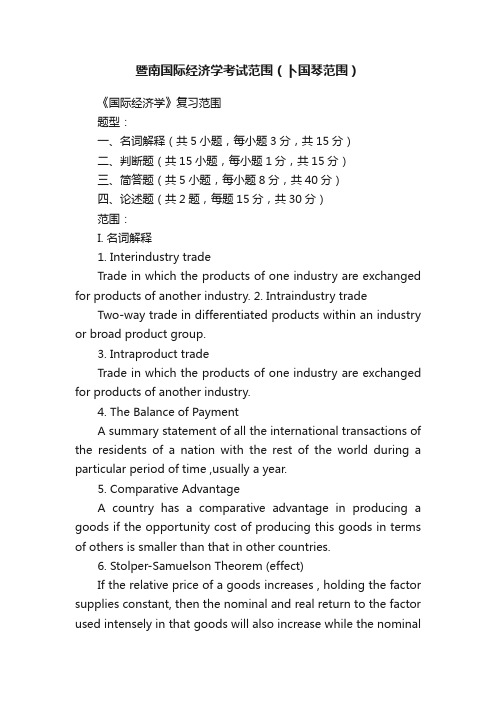
暨南国际经济学考试范围(卜国琴范围)《国际经济学》复习范围题型:一、名词解释(共5小题,每小题3分,共15分)二、判断题(共15小题,每小题1分,共15分)三、简答题(共5小题,每小题8分,共40分)四、论述题(共2题,每题15分,共30分)范围:I. 名词解释1. Interindustry tradeTrade in which the products of one industry are exchanged for products of another industry. 2. Intraindustry trade Two-way trade in differentiated products within an industry or broad product group.3. Intraproduct tradeTrade in which the products of one industry are exchanged for products of another industry.4. The Balance of PaymentA summary statement of all the international transactions of the residents of a nation with the rest of the world during a particular period of time ,usually a year.5. Comparative AdvantageA country has a comparative advantage in producing a goods if the opportunity cost of producing this goods in terms of others is smaller than that in other countries.6. Stolper-Samuelson Theorem (effect)If the relative price of a goods increases , holding the factor supplies constant, then the nominal and real return to the factor used intensely in that goods will also increase while the nominaland real return of others will decrease.7. Heckscher-Ohlin TheoremA country will export goods that use its abundant resources intensely while import those using its scarce factors intensely.8. Factor-Price Equalization TheoremInternational trade leads to complete equalization in the relative and absolute returns to homogenous factors across countries.9. Optimum tariffThe rate of tariff that maximizes the benefit resulting from im provement in the nation’s terms of trade against the negative effect resulting from the reduction of trade.10. Exchange Rate OvershootingThe tendency of exchange rates to immediately depreciate or appreciate by more than required for long-run equilibrium ,and then partially reversing their movement as they move toward their long-run equilibrium levels.11. purchasing power parity (PPP)The theory that postulates that exchange rate depends on relative prices in the two countries.12. Law of one priceThe proposition that in the absence of transportation costs , tariffs and other obstructions to the free flow of trade ,the price of each identical traded commodity will be equalized in all markets by commodity arbitrage.13. The Fisher EffectA rise (fall) in a country’s expected inflation rate will eventually cause an equal rise(fall) in the interests rate that deposits of its currency offer.14.The J-CurveAfter a real currency depreciation, the CA of a country may first worsen and then improve. The changing path of CA in terms of time is like a “J”, so we call this curve “J-Curve” that describes the time lag with which a real currency depreciation improves the CA.15. managed floating exchange ratesThe policy of intervention in foreign exchange markets by monetary authorities to smooth out short -run fluctuations without attempting to affect the long-run trend in exchange rates.16. sterilized interventionA sterilized intervention is the purchase or sale of foreign currency by a central bank to influence the exchange value of the domestic currency, without changing the monetary base. 17. Capital flightCapital flight is a large-scale exodus of financial assets and capital from a nation due to events such as political or economic instability, currency devaluation or the imposition of capital controls.18.vehicle currencyA currency that is widely used to denominate international contracts made by parties who do not reside in the country that issues the vehicle currency.19.interest parityInterest rate parity (IRP) is a theory in which the interest rate differential between two countries is equal to the differential between the forward exchange rate and the spot exchange rate. Taking dollar and euro as examples, the condition is R$ = R€ + (E’$/€ - E$/€)/E$/€. 20.inflation biasHigh inflation with no average gain in output that resultsfrom governments’ policies to prevent recessionII. Give a T(True) or a F(False) for each of the following sayings.涉及每章重要的知识点。
国际经济学复习范围
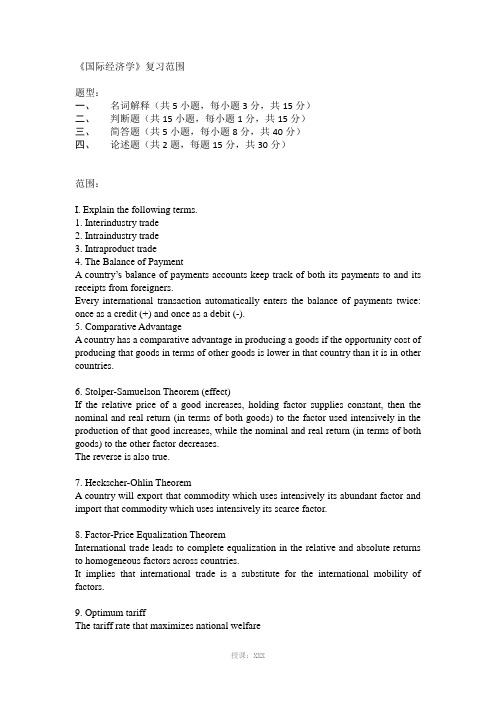
《国际经济学》复习范围题型:一、名词解释(共5小题,每小题3分,共15分)二、判断题(共15小题,每小题1分,共15分)三、简答题(共5小题,每小题8分,共40分)四、论述题(共2题,每题15分,共30分)范围:I. Explain the following terms.1. Interindustry trade2. Intraindustry trade3. Intraproduct trade4. The Balance of PaymentA country’s balance o f payments accounts keep track of both its payments to and its receipts from foreigners.Every international transaction automatically enters the balance of payments twice: once as a credit (+) and once as a debit (-).5. Comparative AdvantageA country has a comparative advantage in producing a goods if the opportunity cost of producing that goods in terms of other goods is lower in that country than it is in other countries.6. Stolper-Samuelson Theorem (effect)If the relative price of a good increases, holding factor supplies constant, then the nominal and real return (in terms of both goods) to the factor used intensively in the production of that good increases, while the nominal and real return (in terms of both goods) to the other factor decreases.The reverse is also true.7. Heckscher-Ohlin TheoremA country will export that commodity which uses intensively its abundant factor and import that commodity which uses intensively its scarce factor.8. Factor-Price Equalization TheoremInternational trade leads to complete equalization in the relative and absolute returns to homogeneous factors across countries.It implies that international trade is a substitute for the international mobility of factors.9. Optimum tariffThe tariff rate that maximizes national welfareIt is always positive but less than the prohibitive rate that would eliminate all imports. It is zero for a small country because it cannot affect its terms of trade.10. Exchange Rate Overshooting11. purchasing power parity (PPP)The exchange rate between two counties’ currencies equals the ratio of the counties’ price levels.It compares average prices across countries.12. Law of one priceIdentical goods sold in different countries must sell for the same price when their prices are expressed in terms of the same currency.13. The Fisher EffectIt is a hypothesis in international finance that suggests differences in nominal interest rates reflect expected changes in the spot exchange rate between countries.he hypothesis specifically states that a spot exchange rate is expected to change equally in the opposite direction of the interest rate differential.14.The J-CurveIf imports and exports adjust gradually to real exchange rate changes, the CA may follow a J-curve pattern after a real currency depreciation, first worsening and then improving.It describes the time lag with which a real currency depreciation improves the CA.15. managed floating exchange ratesA system in which governments attempt to moderate exchange rate movements without keeping exchange rates rigidly fixed.16. sterilized interventionCentral banks sometimes carry out equal foreign and domestic asset transactions in opposite directions to nullify the impact of their foreign exchange operations on the domestic money supply.17. Capital flightThe reserve loss accompanying a devaluation scareThe associated debit in the balance of payments accounts is a private capital outflow.18.vehicle currencyA currency that is widely used to denominate international contracts made by parties who do not reside in the country that issues the vehicle currency.19.interest parityInterest Parity: The Basic Equilibrium ConditionThe foreign exchange market is in equilibrium when deposits of all currencies offer the same expected rate of return.The expected returns on deposits of any twocurrencies are equal when measured in the same currency.20.inflation biasHigh inflation with no average gain in output that results from governments’ policies to prevent recessionII. Give a T(True) or a F(False) for each of the following sayings.涉及每章重要的知识点。
同等学力申硕国际经济学考试大纲(20200801014032)

同等学力经济学综合大纲——国际经济学考试大纲第一章绪论第一节国际经济学的产生与发展一、经济增长的自然过程1.经济增长与经济发展2.微观经济学与宏观经济学的发展脉络3.国际经济的产生二、国际经济学是微观经济学与宏观经济学发展的结果1.经济目标与福利2.封闭经济与开放经济3.国际经济学的产生三、国内经济与国际经济的异同1.经济运行主体的异同2.经济运行目的的异同3.经济运行范围的异同4.经济运行机制的异同5.经济交流方式的异同第二节国际经济学的对象与结构一、国际经济学的基本概念1.资源的国际配置2.福利的国际最大化分析3.国际经济活动往来的内在联系二、国际经济学的研究对象1.国际贸易纯理论研究2.国际贸易政策研究3.国际收支研究4.外汇理论研究5.生产要素的国际流动研究6.跨国公司研究7.经济发展研究8.经济一体化研究9.开放经济的宏观调节研究10.经济全球化与国际经济秩序研究三、国际经济学的分析方法与特点1.宏观与微观相结合2.静态与动态相结合3.定性与定量相结合4.局部均衡与一般均衡相结合5.理论与政策相结合6.吸收与评价相结合第二章国际贸易纯理论第一节斯密的绝对利益学说一、斯密绝对利益学说的基本内容1.斯密绝对利益学说的基本概念与内容2.斯密绝对利益学说的简单数学说明3.斯密绝对利益学说的图形解释4.斯密绝对利益学说的其他有关叙述二、对于斯密绝对利益学说的评价1.从国际贸易实际出发的评价2.从劳动价值论出发的评价第二节李嘉图的比较利益学说一、李嘉图比较利益学说的基本内容1.李嘉图比较利益学说的假设前提2.李嘉图比较利益学说的基本内容3.李嘉图比较利益学说的简单数学说明4.李嘉图比较利益学说的图形解释5.李嘉图比较利益学说的其他有关叙述(多国与多种产品模型)二、对于李嘉图比较利益学说的评价1.从国际贸易实际出发的评价2.从劳动价值论出发的评价3.我国理论界对比较利益学说的认识与评价三、比较利益的分解1.得自贸易的利益2.得自分工的利益3.利益的合成分析与评价第三节国际贸易价格的确定一、相互需求方程式1.相互需求方程式的基本内容和简单数学说明2.相互需求方程的图形解释3.相互需求方程式均衡的条件及对其评价二、提供曲线及其分析1.贸易无差异曲线2.提供曲线的作图及说明3.国际贸易的均衡条件分析4.对提供曲线的评价三、贸易条件与出口的贫困增长1.贸易条件与出口的贫困增长的图形分析2.出口贫困增长的条件与案例3.出口贫困增长的政策含义及对其的评价第三章国际贸易的现代与当代理论第一节H—O 模型及其分析一、H 一0模型的基本命题1.H—O 模型的提出与模型要解决的问题2.H—O 模型的假设前提3.H 一0 模型的基本命题分析二、H 一0 模型的基本内容1.H 一0 模型的基本内在逻辑关系2.H—O 模型的数学公式推导证明3.要素价格均衡及其分析三、对H —0模型的评价1.H 一0 模型与比较利益学说的异同点2.H 一0 模型的政策含义与案例分析3.对H 一0 模型的评价第二节列昂惕夫反论及国际贸易新要素理论一、列昂惕夫反论1.列昂惕夫反论的提出2.列昂惕夫反论的基本内容3.围绕列昂惕夫反论展开的争论二、国际贸易新要素理论1.人力资本说的基本内容与评价2. R&D学说的基本内容与评价3.信息贸易理论的基本内容与评价三、国际贸易产品生命周期理论1. 国际贸易技术差距论的基本内容与评价2. 国际贸易产品生命周期学说的提出与假定前提3. 国际贸易产品生命周期学说的基本内容4. 国际贸易产品生命周期理论的图形说明5. 国际贸易产品生命周期理论的动态意义6. 对国际贸易产品生命周期理论的评价第三节国际贸易的当代理论一、产业内贸易理论1. 产业内贸易理论的提出与假设前提2. 产品的同、异质性3. 同质产品的产业内贸易4. 异质产品的产业内贸易5. 需求偏好相似论6. 规模经济的贸易利益7. 产业内贸易水平的衡量指数8. 对产业内贸易理论的评价二、政策贸易理论1. 战略政策贸易理论2. 贸易扭曲理论第四章国际贸易政策分析第一节国际贸易的关税分析一、小国进口关税的局部均衡与一般均衡分析1. 关税的概念2. 小国进口关税的局部均衡的图形分析3. 小国进口关税的几种经济效应与福利分析4. 小国进口关税一般均衡的图形说明5. 贸易均衡条件分析与评价二、大国关税的局部均衡与一般均衡分析1.大国在国际贸易条件下的总供给曲线2.大国进口关税的局部均衡的图形分析3.大国关税的几种经济效应与福利分析4.大国关税一般均衡的图形说明5.贸易均衡条件分析与评价第二节国际贸易的非关税壁垒分析一、进口配额分析1.国际贸易中进口配额的概念2.进口配额局部均衡的图形分析3.进口配额的经济效应二、进口配额与等额关税的比较分析1.进口配额与等额关税的图形分析2.进口配额与等额关税的政策含义比较3.对进口配额的评价三、反倾销与反补贴分析1.倾销的界定2.倾销的危害性3.倾销的图形分析4.反倾销的经济效应分析5.补贴与反补贴的图形分析第三节幼稚产业的保护一、贸易保护主义的理论基础1.李斯特的贸易保护理论2.新贸易保护理论二、幼稚产业的保护分析1.幼稚产业的定义(M—B—K 标准)2.幼稚产业发展的局部均衡分析3.幼稚产业发展的一般均衡分析4.保护幼稚产业的政策含义与评价三、关税的有效保护率1.关税保护与关税的有效保护2.关税有效保护率公式的推导与计算3.关税有效保护的政策含义与评价第五章国际收支分析第一节国际收支与国际收支表一、国际收支与国际收支表1.国际收支的基本概念2.广义与狭义国际收支3.国际收支表的构成(经常账户、资本和金融账户、国际投资头寸)二、国际收支表各组成部分之间的关系1.国际收支表各项目之间的关系2.国际收支的盈余与赤字3.国际收支状况的含义与经济分析第二节国际收支的调节一、国际收支的失衡1.一国国际收支失衡的含义2.一国国际收支失衡的经济影响二、国际收支失衡调节的若干理论1.弹性法2.吸收法3.货币法三、国际收支失衡的调节措施1.外汇管制2.调整国际收支失衡的其他政策措施第六章汇率决定的一般理论第一节外汇与汇率一、外汇定义及其作用1.外汇的概念2.外汇的作用3.国际储备与最佳外汇储备规模二、汇率定义与汇率的标价法1.汇率定义2.汇率的标价法3.汇率的多种表现形式第二节汇率决定的若干理论一、汇率决定的传统理论1.铸币平价说2.国际借贷说3.传统购买力平价说4.汇兑心理说二、二战后汇率决定的理论1.流动资产选择说2.目标汇率说3.货币主义的汇率理论第三节汇率决定的一般理论内容一、一价定律与购买力平价理论(PPP法) 1.同一价格律2.不同国家中利率与通货膨胀之间的关系3.非贸易商品不符合购买力平价时的平价公式4.贸易商品也不符合购买力平价时的平价公式5.实际汇率分析与评价二、利息平价与远期汇率的决定1.货币的内在价值2.费舍效应与国际费舍效应3.不考虑通货膨胀条件下的远期汇率决定公式4.升水(贴水)公式的推导三、购买力平价法(PPP法)的实际应用1.购买力平价法在国际经济中的应用2.购买力平价法应用的案例分析(发达国家与发展中国家) 3.购买力平价法应用的评价第七章要素的国际流动第一节资本国际流动及其经济效应一、资本国际流动1.资本国际流动的动因2.资本国际流动的主要形式3.国际资本的直接投资与间接投资二、资本国际流动的经济分析1.资本国际流动的图形分析2.资本国际流动的福利分析3.国际资本流动的政策含义三、国际生产折衷理论1.国际生产折衷理论的提出2.国际生产折衷理论的基本内容3.对国际生产折衷理论的评价第二节劳动力国际流动及其经济效应一、劳动力国际流动1.劳动力国际流动的原因2.劳动力国际流动的形式二、劳动力国际流动的经济分析1.劳动力国际流动的图形分析2.劳动力国际流动的福利分析3.国际劳动力流动的政策含义第三节技术转移及其经济效应一、技术的国际转移1.国际技术转移的动因2.国际技术转移的形式二、国际技术转移的经济分析1.技术转移的新古典价格刺激模型2.中性技术进步说3.技术转移的周期理论4.国际技术转移的政策含义第四节国际要素转移的其他经济效应一、两缺口模型1.缺口的概念2.两缺口模型3.两缺口模型的政策含义二、外资引进的经济分析1.国际因素的恶性循环2.最佳外资引进分析3.债务指标及其政策含义4.案例分析:20 世纪80 年代的拉美债务危机第八章宏观经济的内外均衡第一节国际传导机制一、国民收入模型的扩大1.简单开放国民收入模型2.加入商品、资本、劳动力流动的扩大的国民收入模型二、国际经济非均衡传导1.国际商品流动的非均衡传导2.国际资本流动的非均衡传导3.国际劳动力流动的非均衡传导4.国际信息流动的非均衡传导三、国际经济非均衡传导的案例分析1.1973--1974年的世界经济衰退2.1997--1998年的东亚金融经济危机第二节贸易乘数理论一、宏观经济学中的乘数理论1.乘数理论的提出2.乘数理论的公式推导3.乘数的政策含义二、贸易乘数1.贸易乘数理论的提出2.贸易乘数的公式推导3.贸易乘数的图形分析三、贸易乘数的政策意义1.贸易乘数的政策含义2.回应的贸易乘数及其政策含义3.对贸易乘数理论的评价第三节宏观经济的对内与对外均衡一、经济的宏观目标1.宏观经济的四个目标2.经济的对内与对外均衡二、宏观经济内外均衡的经济分析1 •汇率与BOP曲线的关系2. IS-LM —FE分析3.内外均衡的斯旺图分析三、宏观经济内外均衡的政策分析1 .开放条件下的财政、金融与汇率政策2.蒙代尔一弗莱明模型及政策搭配3. 蒙代尔一克鲁格曼三元悖论4. 固定与浮动汇率下的财政政策与货币政策第九章经济一体化与国际经济秩序分析第一节经济一体化分析一、关税同盟与经济一体化分析1. 关税同盟的提出与发展2. 国际贸易的次优理论:贸易创造与贸易转移二、关税同盟的经济分析1.关税同盟的图形分析2.关税同盟的福利分析3.关税同盟的政策含义三、最优货币区分析1.最优货币区的提出2.单一货币的收益分析及其评价3.单一货币区的成本分析及其评价四、经济一体化的经济与案例分析1.经济一体化的经济分析2.经济一体化的案例分析第二节国际经济组织及其作用一、国际货币基金组织(IMF)及其作用二、世界银行(World Bank)及其作用三、世界贸易组织(WTO)及其作用四、地区经济组织及其作用第三节国际经济秩序的建立与南北关系一、国际经济秩序1.国际经济秩序的含义2.旧国际经济秩序分析3.G 一8 与国际经济秩序二、新国际经济秩序1.南北经济关系分析2.新国际经济秩序的提出3.新国际经济秩序的建立第十章结束语:经济全球化趋势第一节经济全球化的演变一、经济全球化的概念与动因二、经济全球化的主要特点第二节经济全球化的影响与发展格局一、经济全球化的影响二、经济全球化的发展格局。
中国社会科学院-院考-国际经济学专业基础课
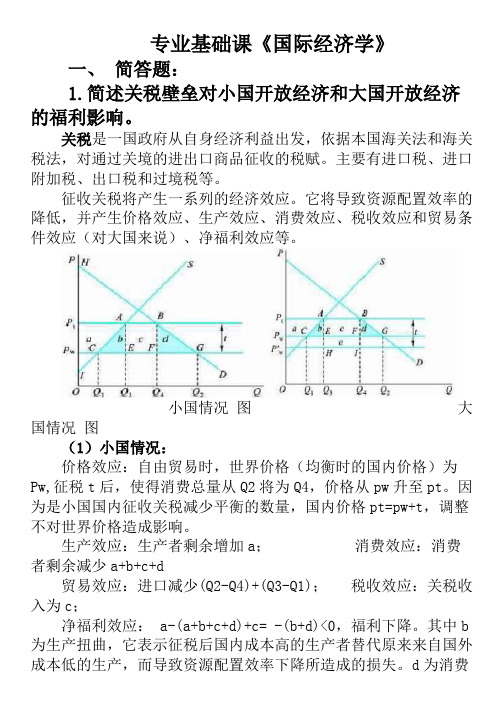
专业基础课《国际经济学》一、简答题:1.简述关税壁垒对小国开放经济和大国开放经济的福利影响。
关税是一国政府从自身经济利益出发,依据本国海关法和海关税法,对通过关境的进出口商品征收的税赋。
主要有进口税、进口附加税、出口税和过境税等。
征收关税将产生一系列的经济效应。
它将导致资源配置效率的降低,并产生价格效应、生产效应、消费效应、税收效应和贸易条件效应(对大国来说)、净福利效应等。
小国情况图大国情况图(1)小国情况:价格效应:自由贸易时,世界价格(均衡时的国内价格)为Pw,征税t后,使得消费总量从Q2将为Q4,价格从pw升至pt。
因为是小国国内征收关税减少平衡的数量,国内价格pt=pw+t,调整不对世界价格造成影响。
生产效应:生产者剩余增加a;消费效应:消费者剩余减少a+b+c+d贸易效应:进口减少(Q2-Q4)+(Q3-Q1);税收效应:关税收入为c;净福利效应: a-(a+b+c+d)+c= -(b+d)<0,福利下降。
其中b 为生产扭曲,它表示征税后国内成本高的生产者替代原来来自国外成本低的生产,而导致资源配置效率下降所造成的损失。
d为消费扭曲,它表示征税后因消费量下降所导致的消费者满意程度的降低,在扣除消费支出的下降部分之后的余额。
(2)大国情况初始世界价格为Pw,因为是大国,其国内随关税减少的需求将影响世界范围的供给增加,从而降低世界范围的价格至pw’,最终国内均衡价pt=pw’+t由于征收关税t,使得消费总量总Q2降为Q4,价格从pw升值pt。
此外征税前后,进口商品的价格从pw 降为pw’。
消费者剩余减少a+b+c+d;生产者剩余增加a;关税增加c+e;价格效应:征收关税会降低世界市场价格,即世界价格由Pw 降为P’ w。
贸易条件效应:征税前Q3Q4的进口价格为EFQ3Q4,征税后为HIQ3Q4,进口数量减少了(Q2-Q4)+(Q3-Q1),征税国贸易条件改善,收益e;净福利效应: a-(a+b+c+d)+ (c+e) =e-(b+d)。
国际经济学考研知识重点整理

国际经济学考研知识重点整理题型:名词解释(20)选择题(20)简答题(20)论述题(20)均考察基本的概念原理思想第三章(两颗星)劳动生产率和比较优势:李嘉图模型1.名词解释:比较优势机会成本2.理解书P33 图3.3的相关理论知识(核心重点!)3.做课后习题1 P494. P41 了解多种产品模型中的比较优势(仅了解)第四章(三颗星)资源、比较优势与收入分配(此章为核心重点)1.名词解释:要素密集度、丰裕度2.斯托尔珀-萨缪尔森效应图4.6 P56 P573.生产偏向定理 P61 右下角雷布金斯基 P60 4.10 。
的增加会造成4.里昂惕夫悖论 P725.要素价格均等化定理 P64 P656.资源、要素、供给、资源货币禀赋理论贸易对两国不同要素所有者的影响充裕所有者受利稀缺要素者利益受损(可能会出单选不要只背两句话)第五章标准贸易模型(重点放在理论的应用开放经济标准模型考的少)1.主要考贸易的影响收入转移对贸易的影响取决于边际支出倾向的不同2.关税的出口影响图5.8 相对价格1—2.3.关税和出口补贴对贸易影响(和第八章联系起来)4.基本概念:经济偏向增长出口/进口~5.福利恶化型增长6.为什么福利恶化型在现实中不太可能出现?因为供给和需求在很随机的情况下7.按章分:国际收入转移(RD曲线的移动,关税和出口补贴:RS曲线和RD曲线同时移动)第六章规模经济、不完全竞争和国际贸易(两颗星)1. 概念:规模经济两种类型产业内贸易模式学习曲线2. 规模经济下衡量国际贸易者利益应该从哪两方面:1.从消费者可选商品种类增加的角度 2.一体化市场使价格降低的角度结论——发展国际贸易3. 规模经济——产业内贸易与产业间贸易差异越来越大 P124第八章贸易的政策工具(两颗星)1. 名词:出口补贴出口配额配额租金自愿出口限制非关税配额2. 关于关税的分析:在大国怎么分析关税收益/成本生产者大国总体最后做一个福利分析 e-(b+d)=结论国际经济学重点整理题型:名词解释(20)选择题(20)简答题(20)论述题(20)均考察基本的概念原理思想第三章(两颗星)劳动生产率和比较优势:李嘉图模型1.名词解释:比较优势机会成本2.理解书P33 图3.3的相关理论知识(核心重点!)3.做课后习题1 P494. P41 了解多种产品模型中的比较优势(仅了解)第四章(三颗星)资源、比较优势与收入分配(此章为核心重点)1.名词解释:要素密集度、丰裕度2.斯托尔珀-萨缪尔森效应图4.6 P56 P573.生产偏向定理 P61 右下角雷布金斯基 P60 4.10 。
国际经济学大纲(复试)

1.要求考生熟练掌握国际间经济合作的含义、类型、阶段以及静态和动态效应模型的经济分析原理。
2.要求考生熟悉掌握劳动力流动的种类、原因以及经济效应分析原理。
3.要求考生了解资本流动的种类、原因以及经济效应分析原理。
考试总分:200分考试时间:小时考试方式:笔试
考试题型:名词解释(20分)
3.要求考生熟练掌握关税及非关税壁垒的种类及经济分析的意义及过程。
三、汇率、国际收支理论
1.要求考生熟练掌握汇率的种类及外汇的交易类型。
2.要求考生熟练掌握购买力平价、利率决定等汇率决定理论的含义及推导过程。
3.要求考生了解国际收支的含义、构成以及国际收支的决定理论。
4.要求考生熟练掌握国际间经济调节政策、一国的内外平衡政策以及经济分析推导过程。
2018年考试内容范围说明
考试科目代码:空考试科目名称: 国际学的研究对象。
2.要求考生熟练掌握国际经济学的研究内容。
3.要求考生了解学习国际经济学的必要性。
二、国际贸易理论
1.要求考生熟练掌握比较优势、要素禀赋等理论的内容。
2.要求学生熟练掌握重叠需求理论、垄断竞争理论、产品生命周期理论、幼稚产业保护理论、贸易条件理论、发展中国家的贸易理论的经济分析过程及原理。
计算题(30分)
简答题(80分)
论述题(70分)
《国际经济学》考试大纲(Internationaleconomicsexaminationo

《国际经济学》考试大纲(International economics examinationoutline )Long time no upload documents, recently found a few good documents, upload up, and share with youInternational economics examination outlineTextbook, International EconomicsScience PressQiu Jizhou series2005 EditionI, the nature of the course and the purpose and requirements of the testInternational economics is a major course in international economics and tradeInternational economics studies the allocation of resources in an open economy and the resulting economic and economic relations across bordersIts content is to explain the international trade theory, international trade policy, international finance theory and international international finance finance finance policy under policy under policy under the open economy the open economy the open economy condition condition The advanced courses in international economics are mainlyinternational trade, international finance, international economic cooperation, and international trade practiceLearn through this courseThe ability to analyze and solve problems can be further improvedLearn through this courseStudents are required to master the basic theories of international economics, the basic methods of international economics and the unity of theoretical analysis and empirical analysis in a comprehensive and systematic wayTake into account both empirical analysis and normative analysisII. Assessment objectivesChapter one is the theory of comparative advantageI. assessment of knowledge points1, the principle of absolute advantage;2, the principle of comparative advantage;3, opportunity cost and comparative advantage;4, international trade under the condition of increasing costTwo, assessment requirements1, remember: the principle of absolute advantage and comparative advantage principle, opportunity cost2, understand: the relationship between the principle of absolute advantage and the principle of comparative advantage, the relationship between opportunity cost and comparative advantage, cost deliveryIncreased trade patternsThe second chapter is trade balance theoryI. assessment of knowledge points1. 1. Equilibrium analysis: the Equilibrium analysis: the Equilibrium analysis: the production possibility production possibility production possibility curve and curve and the social indifference curve;2, equilibrium analysis: supply curve and demand curve3, provide curves and terms of trade4, international trade based on preference differenceTwo, assessment requirementsL, remember: the production possibility curve, socialindifference curve, the supply and demand curves, curve, tradeConditions and preference differences2, understand: General Equilibrium Analysis of international trade, partial equilibrium analysis of international trade and the meaning of terms of tradeThe third chapter, factor endowment theoryI. assessment of knowledge points1, H-O model2, the impact of international trade on the short-term income of factor of production3 and Stolpes Samuelson theorem4, the factor price equalization theorem5, leentiefTwo, assessment requirements1, remember: the factor intensity, factor abundance, Stolper Samuelson theorem, and factor price equalization theorem, The leentief, factor intensity transform2. Comprehend the content of H-O model, the relation between international trade and factor income distribution and the theorem of factor price equalizationThe meaning and the leentief explanation,The fourth chapter is modern trade theoryI. assessment of knowledge points1, economies of scale and international trade2, imperfect competition and international trade3, demand structure trade theory4, technology gap, trade theoryTwo, assessment requirementsL, remember: monopolistic competition, economies of scale, product difference2. 2. Understanding: Understanding: Understanding: the relationship the relationship the relationship between economies between economies between economies of of of scale scale and international trade, the concept and causes of intra industry trade, and the theory of preference similarityContent, technical gap, content of trade theoryThe fifth chapter is about the basic principle of tariffI. assessment of knowledge points1, the concept and kind of tariff2, tariff effects: small country situation3, tariff effect: big country situation4, the optimal tariff theory5, tariff structure theoryTwo, assessment requirements1, remember: the concept, types, tariff tariff tariff, tariff effect, effect of small power optimal tariff theoryIts meaning, effective protection rate and tariff structure2, understand: the difference and comparison of different customs duties, the methods and characteristics of tariff collection and the partial equilibrium of small tariff effectAnalysis, the partial equilibrium analysis of the big country effect of tariff, the measurement of the optimum tariff theory and the effective rate of protectionCalculation and analysisThe sixth chapter is non tariff trade policy and discriminatory trade policyI. assessment of knowledge points1, import quotas2, export policy3, other non-tariff barriers4, strategic trade policy5. International cartels6, discriminatory trade policy7. Trade policy and the industrialization strategy of developing countries8, trade systemTwo, assessment requirements1, remember: import quota, import license, voluntary export restrictions, restrictions, export export subsidies subsidies and and countervailing countervailing duties, duties, the dumping of goods,Discriminatory government procurement, technical barriers, strategic trade policy content, and regional economic integrationTrade creation, creation, trade trade diversion, diversion, import import substitution substitution strategy strategy and export oriented strategy2, understand the economic effects of import quotas, the modeof distribution of import licenses, the economic effects of export subsidies and dumping,The content of the customs union theoryThe seventh chapter is about trade policy and trade system I. assessment of knowledge points1, the welfare basis of the trade protection policy2. Trade policy and the industrialization strategy of developing countries3, trade systemTwo, assessment requirements1, remember: the second best theory, infant industry protectiontheory, theory of terms of trade, import substitution strategy, the export oriented strategy,Trade system, GATT., most favored nation treatment, national treatment2. Comprehend the content and significance of the theory of infant industrial protection, the role of GATT, GATT and WTO RelationshipThe eighth chapter is the balance of payments accountI. assessment of knowledge points1. Balance of payments and balance of payments account2, the structure of the balance of payments account3, the balance of payments and the balance of payments4. Balance of payments and national income accountsTwo, assessment requirements1, remember: the international balance of payments the concept of international balance of payment, account of the concept,the international balance of payments, current account, capitalThe project, the balance of the project, autonomous transaction,regulatory trade, GDP, 2 of GDP, understand: BOP, BOP content analysis method, the balance of payments and the national incomeAccount relationshipThe ninth chapter: foreign exchange marketI. assessment of knowledge points1, foreign exchange, exchange rates and foreign exchange markets2, foreign exchange transactions3, foreign exchange supply and demand4. Foreign exchange controlTwo, assessment requirements1, memory: the concept of foreign exchange and exchange rate concept, direct quotation, indirect quotation, spot foreignexchange transaction, forwardThe concept of foreign exchange trading, options trading, stability, speculative arbitrage, equilibrium in the foreignexchange market, foreign exchange control2, understand: types of foreign exchange, exchange rate relations, foreign exchange market classification methods, forward foreign exchange rate premiumFlat arbitrage principle and calculation, transaction process, hedging transactions, foreign exchange market equilibrium contentTypes, the economic basis of foreign exchange control and the harm of foreign exchange controlThe tenth chapter is exchange rate theoryI. assessment of knowledge points(I) exchange rate mechanism of the gold standard(two) purchasing power parity theory(three) monetarist exchange rate theory(four) asset balance exchange rate theory(five) economic effects of exchange rate changes;Two, assessment requirementsL, remember: (1) the gold standard (2) mint parity (3) the theory of purchasing power parity (4) substitution effect (5)economyEffect2. Understanding: the reason why the exchange rate fluctuates on the basis of mint parity, the content of purchasing power parity theory, MonetarismThe content of exchange rate theory, the asset balance, the content of exchange rate theory and the economic effects of exchange rate changesThe eleventh chapter, adjustment of balance of paymentsI. assessment of knowledge points(1) reasons for the imbalance of international payments and the adjustment mechanism;(two) price adjustment theory(three) income adjustment theory(four) monetary adjustment theoryTwo, assessment requirementsL, remember: (1) the concept of the Marshall Lerner condition (2) J (3) - curve effect price specie flow mechanism2, understand: (1) the reason of global imbalances (2) adjustment adjustment mechanism mechanism mechanism of of international international payments payments imbalances imbalances (3) (3) Marshall Lerner.The economic meaning of the article (4) the relation between the devaluation and the terms of trade (5) the multiplier theory of the international balance of payments(6) the adjustment of the balance of payments currency under the fixed exchange rate (7) the balance of payments under the floating exchange rateMonetary adjustmentThe twelfth chapter is the international monetary systemI. assessment of knowledge points(I) comparison of exchange rate regimes(two) Bretton Woods system;(three) the Jamaica monetary agreement and the managed floating exchange rate regime;(four) European Monetary IntegrationTwo, assessment requirements1, remember: (1) the peg (2) the Bretton Woods Monetary Agreement (3) Jamaica (4) management floating exchangeRate mechanism (5) joint floating (6) optimum currency area2, understand: (1) comparison of fixed exchange rate system and floating exchange rate system (2) the main contents of Bretton Woods system (includingIts function and main defects) (3) the main contents of the Jamaica monetary agreement (4) European Monetary IntegrationcourseRequirements for explanation and ImplementationI. directions for examination objectivesIn order to make the examination content concrete and theexamination request targetThis examination syllabusOn the basis of listing the content of the examinationThe examination objectives are set out in each chapterTo enable candidates to further clarify the content and requirements of the examinationMore systematically study the teaching material, and make the test proposition clearerMore accurately arrange the knowledge, ability level and difficult procedure of the test questionsThe examination outline is in the assessment targetAccording to records, understand the provisions of its two levels should reach the ability level requirementsThe two ability levels are progressive hierarchiesWhat are the implications of the levels of competence?: Remember: to know about nouns, concept, the meaning of knowledgeAnd can correctly understand and expressUnderstand: Based on recognitionBe able to grasp the basic concepts, basic norms and basic methodsBe able to grasp the differences and relations between concepts, norms and methodsAnd internalize your actual ability to workTwo, proposition examination requirementsL and international economicsWithout special requirementexamination andand strictly limitedlimited to the scope of the examination Should be strictlyexamination objectives outlined in this outlineExamination coverage should include chapters of teaching materialsAnd properly highlight key chapters2, the content of the examination should be reasonable arrangement of difficulty structureGenerally speaking, "Yi" accounts for 20%"Easy" accounted for 30%"Difficult" accounts for 30%"Difficult" accounts for 20%3, this course examination adopts closed winding modeThe exam time is 120 minutesThe size of the examination examination questions questions questions should should should be be adapted adapted to to the examination time4, this course examination paper may use the questions include: noun explanation, fill in the blanks, individualmultiple-choice questions, non - judgmental questions,calculation questions, brief questions, discussion questions and so onCheck total scoreReviewerTotal scoreTitle numberOneTwoThreeFourFiveSixSevenQuestion scoreIdentical personScoreScoreThe markingReexamination man1. in the model of comparative advantageThe international parity of two types of traded goodsA. on the domestic price of the two commodities before the trade between the two countriesB. at the domestic parity of the two commodities before the two countries tradeC. the domestic parity between the two commodities before thetrade between the two countriesD. has the same domestic parity as any other country before trade2. which of the following does not belong to speculative foreign exchange trading?A. A.B.C. bilateral multilateral B. C. bilateral multilateral B. C. bilateral multilateral arbitrage arbitrage arbitrage arbitrage arbitrage arbitrage arbitrage arbitrageD. hedging3. from the internal balanceExpansionary monetary policy will make ()A. outflows of funds,B. interest rates fell byC., trade balance improvedD., import demand decreasedFourOf or relating to a tariff barrierA. import surcharge,B. export subsidy,C. public procurement,D. voluntary export restriction5., China's current exchange rate system is ()A. fixed exchange rate system,B., fully free floating exchange rate,C., managed floating exchange rate,D. pegged exchange rate6., multinational companies have and maintain their unique monopoly advantagesIs an important factor in its investment abroadThe theory is ()A. location advantage theoryB. monopoly advantage theoryC. market internalization theoryD. theory of international production integration7., the price under the gold standard - the basic operation way of mint flow mechanism can be summed up as ()A. trade deficit - gold inflows - money supply - domesticcommodity prices - export growth, imports decline - trade balance improvedB. balance of trade deficit - Gold outflow - reduced moneysupply - lower domestic commodity prices - increased exports and reduced imports - improved trade balanceC. trade surplus - gold inflows - an increase in the money supply - lower domestic commodity prices - lower exports, higher imports - improved trade balanceD. trade surplus - Gold outflows - reduced money supply - lower domestic commodity prices - lower exports, increased imports - improved trade balance8., C is the marginal propensity to consumeS is marginal propensity to saveM is marginal import propensityUnder the open economy, the foreign trade multiplier is ()A.1 / sB.1 / (1-C)C.1 / (s+m)D.1 / (1-s-m)9. control foreign exchange expenditures by residents Maintain the stability of the external value of the currency This method is called ()A. foreign exchange control,B. financing fund,C. import quota quota,D. adjustment economy10., the relative superiority of the factor of production was first proposed, which led to economists in international trade A., Adam Smith, B., David Ricardo, C., David sue, desert, D., Eli Heckscher11. according to the characteristics of the products, the standards of tariff collection are determined respectivelyThen choose one way to impose customs dutiesThis duty is called ()From the amount of ad valorem tax B. A. C. mixed tax D. tax12., international trade has different effects on different interest groupsIt is generally believed that the import of goods is beneficial to a countryA. consumer group,B. producer group,C., foreign consumer group,D., foreign government agencies13., according to the devaluation of the J curve effect" The initial period after the devaluation of the currency Trade balance ()A. improvesB. deterioration,C. does not change, andD. changes are uncertain14. the highest authority of the world trade organization is ()A. Secretariat,B. ministers meeting,C. General Council,D. Committee15. producer surplus means ()A. below supply curvePrice curve above and vertical axis enclosed partB. below supply curveThe price curve follows the vertical axisC.Above supply curvePrice curve above and vertical axis enclosed partAbove the supply curve of D.The price curve follows the vertical axis16. the SDR is essentially a ()A. currency,B. funds,C. claims,D. accounting units17. the following measures for non-tariff barriers are ()A. anti-dumping duties,B. countervailing duties,C. import surcharges,D. domestic minimum price18. the GATT has conducted rounds of multilateral trade negotiationsThe longest negotiating time is ()A. Geneva round,B. Tokyo round,C. Uruguay round,D., round19., the countries that adopt import substitution strategies are not inclined to use policiesA. barriers to import tariffs,B. barriers to non-tariff barriersC. controls foreign exchange, andD. underestimates the external value of its currency20., if the euro against the dollar exchange rate from EURI=USD0.8925 to EURI=USD0.8740Explain ()A. dollar appreciationThe euro depreciated and the value of the B. depreciatedEuro appreciationC. Euro unchangedDollar depreciation, D. Euro unchangedDollar appreciationScoreThe markingReexamination man21., the basic features of protective tariffs are22., the main characteristics of multinational corporations are internationalization, centralized management and23. the policy tools of import substitution strategy are mainly protective protective tariff tariff tariff and overvalued local and overvalued local and overvalued local currency exchange currency exchange currency exchange rate rate24. is the earliest in the worldIt is also the most basic mode of a special economic zone25. generally believe thatDebt service ratio is lower than that of financial expenditureThe most important principle in the 26. World Trade Organization is that27. means complete economic integrationThat is, member states are in complete agreement with trade, currency, finance, etc.The realm of free flow of goods, capital, and labor28., the Bretton Woods system established a central international monetary system29. export controls include unilateral export controls and twobasic forms30., in order to achieve the purpose of international reserve structure managementIn management, the basic principles of safety, liquidity and profitability should be followedScoreThe markingReexamination man31., consider international investment as an international exchangeIt means using the future goods to exchange the present goods ()The establishment of the 32. customs union may contribute to the formation of new monopolies()33. when the direct quotation is used to indicate the foreign exchange rateThe greater the valueMeans the higher the value of the local currency()34. Bretton Woods system confirms the legalization of floating exchange rate()35. immigration will have an impact on the international labour market()ScoreThe markingReexamination man36. international economyScore37. Economic CommunityScore38. foreign exchange controlScore39. carry tradeScore40. reflow effectScoreScoreThe markingReexamination man41. what is the nature of the disequilibrium of balance of payments?Score42., what is the positive impact of FDI on state-owned capital?Score43. e-commerce compared with traditional trade patternsWhat are the advantages?Score44., what are the main functions of foreign exchange?Score45. what are the characteristics of the international investment fund?ScoreScoreThe markingReexamination man46. briefly analyze the characteristics and advantages of managed floating exchange rate systemScorebranch47., try to analyze the positive and negative role of tariff Score。
经济学浙江省考研经济学国际经济学重点
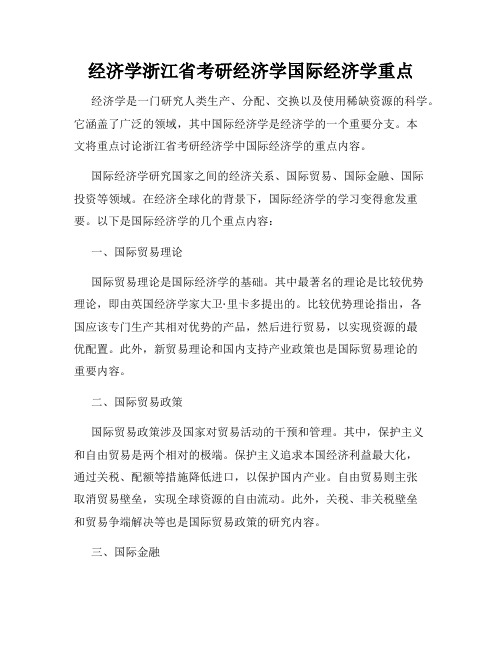
经济学浙江省考研经济学国际经济学重点经济学是一门研究人类生产、分配、交换以及使用稀缺资源的科学。
它涵盖了广泛的领域,其中国际经济学是经济学的一个重要分支。
本文将重点讨论浙江省考研经济学中国际经济学的重点内容。
国际经济学研究国家之间的经济关系、国际贸易、国际金融、国际投资等领域。
在经济全球化的背景下,国际经济学的学习变得愈发重要。
以下是国际经济学的几个重点内容:一、国际贸易理论国际贸易理论是国际经济学的基础。
其中最著名的理论是比较优势理论,即由英国经济学家大卫·里卡多提出的。
比较优势理论指出,各国应该专门生产其相对优势的产品,然后进行贸易,以实现资源的最优配置。
此外,新贸易理论和国内支持产业政策也是国际贸易理论的重要内容。
二、国际贸易政策国际贸易政策涉及国家对贸易活动的干预和管理。
其中,保护主义和自由贸易是两个相对的极端。
保护主义追求本国经济利益最大化,通过关税、配额等措施降低进口,以保护国内产业。
自由贸易则主张取消贸易壁垒,实现全球资源的自由流动。
此外,关税、非关税壁垒和贸易争端解决等也是国际贸易政策的研究内容。
三、国际金融国际金融是国际经济学中的重要组成部分。
国际金融研究国际货币体系、汇率决定、国际支付、国际金融机构等问题。
其中,国际货币体系是国际金融领域的核心。
不同国家的货币之间的汇率决定了国际贸易和资本流动的规模和方向。
四、国际投资国际投资研究跨国公司的跨国经营行为以及外国直接投资等问题。
跨国公司在全球范围内的扩张和运作对国际经济产生了巨大的影响。
外国直接投资是国际投资的主要形式,它涉及到投资者在海外市场购买、建立和控制生产设施、企业的行为。
对于浙江省考研经济学中的国际经济学重点,考生需要掌握上述基本概念和理论,并了解当前国际经济形势和热点问题。
此外,熟悉相关数据、统计方法以及经济学的分析工具也是必备的。
以上便是浙江省考研经济学中国际经济学的重点内容。
研究国际经济学不仅对于走出国门、参与国际经济交往的个人和企业有着重要意义,也对于掌握经济全球化背景下的经济发展规律和国际竞争力的提升至关重要。
- 1、下载文档前请自行甄别文档内容的完整性,平台不提供额外的编辑、内容补充、找答案等附加服务。
- 2、"仅部分预览"的文档,不可在线预览部分如存在完整性等问题,可反馈申请退款(可完整预览的文档不适用该条件!)。
- 3、如文档侵犯您的权益,请联系客服反馈,我们会尽快为您处理(人工客服工作时间:9:00-18:30)。
国际经济学试题 A卷
每份试题满分100分,考试时间2小时
一、单项选择题(每题2分,共16分)
1、国际贸易中的小国是指
A、人口少
B、国土面积小
C、在市场上是价格的接受者
D、在市场上时价格的决定者
2、需求变动时,配额将导致
A、价格调整
B、进口量调整
C、产量调整
D、消费量调整
3、名义利息率R、实际利息率A和通货膨胀率I之间的关系是
A、A=R+I
B、A=R—I
C、R=A+I
D、R=A—I
4、不属于二战后汇率决定理论的是
A、流动资产选择说
B、汇兑心理说
C、目标汇率说
D、货币主义汇率理论
5、偿债率是
A、未偿还外债余额/出口收入
B、当年还本付息/出口收入
C、未偿还外债余额/国民生产总值
D、未偿还债务现值/国民生产总值
6、由于大国可以左右市场价格,即将关税负担转移给国外出口商,那么
A、一定会导致福利净损失
B、一定会导致福利净收益
C、一定会导致既无净损失也无净收益
D、以上均不一定
7、当国际收支顺差时,按吸收法应
A、提高生产能力
B、压制生产能力
C、扩张消费、投资和政府开支
D、压缩消费、投资和政府开支
8、国际交换比率接近外国国内交换比率,说明
A、对手对于本国商品的需求强度大于本国对于本国商品的需求强度
B、对手对于本国商品的需求强度大于本国对于对手商品的需求强度
C、对手对于本国商品的需求强度小于本国对于本国商品的需求强度
D、对手对于本国商品的需求强度小于本国对于对手商品的需求强度
二、名词解释 (每题4分,共16分)
1、经济全球化
2、贸易条件
3、国际货币基金组织
4、外汇
三、简答题(每题7分,共28分)
1、简述列昂惕夫反论
2、简述国际经济非均衡传导机制
3、简述国际贸易新要素理论
4、亚当斯密绝对利益学说的基本内容
四、论述与计算题(每题20分,共40分)
1、论述H—O模型的内在逻辑、基本论点及其意义,并做简要评价
2、试述国际收支失衡的三个调节理论
国际经济学试题 B卷
每份试题满分100分,考试时间2小时
一、单项选择题(每题2分,共16分)
1、由于大国可以左右市场价格,即将关税负担转移给国外出口商,那么
A、一定会导致福利净损失
B、一定会导致福利净收益
C、一定会导致既无净损失也无净收益
D、以上均不一定
2、当国际收支顺差时,按吸收法应
A、提高生产能力
B、压制生产能力
C、扩张消费、投资和政府开支
D、压缩消费、投资和政府开支
3、国际交换比率接近外国国内交换比率,说明
A、对手对于本国商品的需求强度大于本国对于本国商品的需求强度
B、对手对于本国商品的需求强度大于本国对于对手商品的需求强度
C、对手对于本国商品的需求强度小于本国对于本国商品的需求强度
D、对手对于本国商品的需求强度小于本国对于对手商品的需求强度
4、不属于二战后汇率决定理论的是
A、流动资产选择说
B、汇兑心理说
C、目标汇率说
D、货币主义汇率理论
5、偿债率是
A、未偿还外债余额/出口收入
B、当年还本付息/出口收入
C、未偿还外债余额/国民生产总值
D、未偿还债务现值/国民生产总值
6、国际贸易中的小国是指
A、人口少
B、国土面积小
C、在市场上是价格的接受者
D、在市场上时价格的决定者
7、需求变动时,配额将导致
A、价格调整
B、进口量调整
C、产量调整
D、消费量调整
C、扩张消费、投资和政府开支
D、压缩消费、投资和政府开支
8、名义利息率R、实际利息率A和通货膨胀率I之间的关系是
A、A=R+I
B、A=R—I
C、R=A+I
D、R=A—I
二、名词解释 (每题4分,共16分)
1、外汇
2、国际货币基金组织
3、贸易条件
4、经济全球化
三、简答题(每题7分,共28分)
1、简述国际贸易新要素理论
2、简述国际经济非均衡传导机制
3、简述列昂惕夫反论
4、亚当斯密绝对利益学说的基本内容
四、论述与计算题(每题20分,共40分)
1、试述国际收支失衡的三个调节理论
2、论述H—O模型的内在逻辑、基本论点及其意义,并做简要评价。
